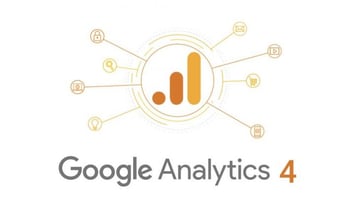Introduction: Welcome to our informative blog post on GA4 Migration and Tapclicks Visualization! In...
Your Guide to Google Analytics 4: Common Questions and New Features

Google Analytics (GA) is undoubtedly one of the world's most popular web analytics tools. It allows digital marketers and website owners to track and analyze website traffic, user behavior, and engagement. In October 2020, Google introduced the latest version of GA, GA4, which comes with several new features and functionalities. In this blog post, we will address some of the most common questions that marketers have about GA4.
- What is the difference between GA4 and Universal Analytics?
GA4, the latest version of Google Analytics, uses an event-based data model, whereas Universal Analytics (UA) uses a session-based model. This means that GA4 allows you to track more detailed information about user behavior, such as specific clicks or interactions, rather than just pageviews. Additionally, GA4 offers improved cross-device tracking, which enables you to see how users engage with your website across multiple devices.
When it comes to web analytics, the data model is an essential concept that can determine the level of detail you can extract from your analytics data. Universal Analytics (UA), the previous version of Google Analytics, uses a session-based data model, which groups user interactions into sessions based on a defined timeout period. In contrast, GA4, the latest version of Google Analytics, uses an event-based data model, which records every user interaction on your website as an event.
The event-based model of GA4 is a significant departure from UA and has several advantages. For one, it allows marketers to track more detailed information about user behavior, such as specific clicks or interactions, rather than just pageviews. This level of detail enables marketers to better understand how users engage with their website and identify areas where they can optimize the user experience.
Another significant advantage of GA4's event-based data model is improved cross-device tracking. In today's digital landscape, users often switch between multiple devices when browsing the web, which can make it challenging to track user behavior accurately. However, GA4's event-based model allows marketers to track user behavior across multiple mobile, desktop, and tablet devices. This capability provides a more comprehensive view of user behavior, enabling marketers to optimize their marketing campaigns for different devices and channels.
Overall, GA4's event-based data model represents a significant upgrade from UA's session-based model. Its ability to track user behavior at a more granular level and across multiple devices provides marketers with a more comprehensive view of their users' behavior, enabling them to make data-driven decisions that drive better business outcomes. If you haven't already made the transition to GA4, it's worth considering the benefits it can offer your marketing efforts.
- Can I still use UA?
Yes, you can still use UA alongside GA4. However, Google recommends that you transition to GA4 as soon as possible, as UA will eventually be phased out. It's worth noting that GA4 and UA data cannot be combined or compared directly since they use different data models.
There are a couple of important points that marketers need to keep in mind as they make the transition from Universal Analytics (UA) to GA4.
Firstly, there is a pending deadline of July 1st, 2023, after which GA4 will become the default for all new properties created in Google Analytics. This means that if you have not already made the transition to GA4, it is essential to do so before this date. After July 1st, any new properties created in GA will automatically use GA4. This deadline is important because it gives marketers a fixed timeframe to complete the transition and ensure that they are not missing out on valuable data.
Secondly, Google plans to erase all historical data from UA on October 31st, 2023. This means that any data collected in UA will no longer be available after this date, and if you have not already migrated to GA4, you will lose access to all of your historical data. It is crucial to migrate to GA4 as soon as possible to avoid losing any valuable data that could be used to inform your future marketing efforts.
It is also important to note that GA4 offers several new features that were not available in UA, including the ability to track user behavior across multiple devices and analyze user behavior in conversion funnels. Additionally, GA4 uses machine learning to provide marketers with AI-powered insights into user behavior and marketing performance, which can help to identify opportunities for optimization and growth.
Marketers need to be aware of the pending deadlines for data collection and the erasure of historical data in UA. They should transition to GA4 as soon as possible to avoid losing any valuable data and take advantage of the new features that GA4 offers. By doing so, they can better understand their users' behavior, optimize their marketing campaigns, and ultimately drive better business results.
- How do I set up GA4?
Setting up GA4 is a bit different from setting up UA. First, you need to create a new GA4 property in your Google Analytics account. Then, you need to add the GA4 tracking code to your website. Finally, you need to configure your event tracking and conversion goals in the GA4 interface.
- What are events, and how do I track them in GA4?
Events are user interactions with your website, such as clicks, form submissions, or video plays. In GA4, you can track events using the gtag.js tracking code. You need to add an event parameter to the code for each event you want to track. For example, to track clicks on a specific button, you would add the following code:
gtag('event', 'click', {'event_category': 'Button', 'event_label': 'Download PDF'});
This code tells GA4 to track a click event with the category "Button" and label "Download PDF."
- How do I set up conversion tracking in GA4?
To set up conversion tracking in GA4, you need to create a conversion event. You can do this by going to the "Events" section of the GA4 interface and clicking "Create event." From there, you need to select a conversion event template or create a custom event. Once you've created the event, you can use it to track conversions in your marketing campaigns.
- What are some of the other new features in GA4?
GA4 offers several new features that were not available in UA, including:
- Improved cross-device tracking: You can now track user behavior across multiple devices, including mobile, desktop, and tablet.
- AI-powered insights: GA4 uses machine learning to provide insights into user behavior and marketing performance.
- Funnel analysis: You can now analyze user behavior in conversion funnels to identify areas where users are dropping off.
- Enhanced data controls: GA4 offers more control over data collection and processing, including the ability to delete user data and control how data is shared with Google.
Where can I find support for Google Analytics 4?
Google offers several resources for support with Google Analytics 4, including:
- Google Analytics Help Center: This resource provides articles, videos, and FAQs to help you troubleshoot issues and get the most out of your Google Analytics 4 account.
- Google Analytics Community: The Google Analytics Community is a forum where users can ask and answer questions related to Google Analytics 4.
- Google Analytics Academy: Google Analytics Academy provides free online courses to help users learn how to use Google Analytics 4 and improve their data analysis skills.
- Google Support: If you have an issue that can't be resolved through the above resources, you can contact Google Support for further assistance.
In conclusion, GA4 is a significant upgrade from UA and offers several new features that can help marketers better understand user behavior and improve their marketing campaigns. While it may take some time to get used to the new data model and tracking methods, the benefits of using GA4 are well worth the effort. If you have any more questions about GA4, feel free to reach out to the TapClicks team for help.
Some content sourced from https://www.tapclicks.com/resources/blog/the-most-common-questions-we-get-asked-about-ga4/



